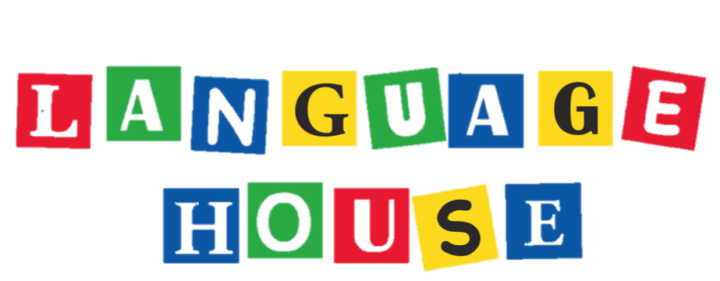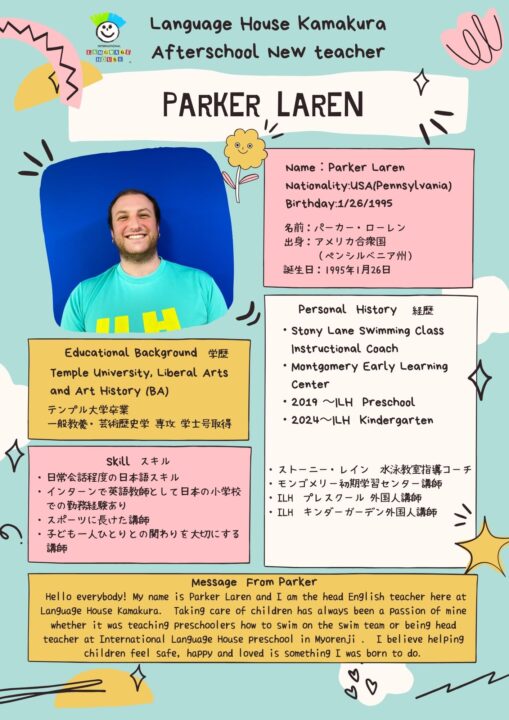

Kamakura offers
an engaging
program
for your child
Language House
Bilingual Care
ランゲージ•ハウスは‘話せる英語’を柱に、卒園までに外国人とコミュニケーションができる能力と、感性を持って美しい日本語を話す子どもたちを育てています。
今、鎌倉という伝統ある町に住む子どもたちに寄り添いながら、世界の動きを見据えた教育にチャレンジしていきます。
While Language House is committed to developing our childrens’ ability to communicate with foreigners using English, we simultaneously emphasize their ability to speak eloquent native Japanese by the time they graduate from our school.
In the same manner, we challenge ourselves in our approach towards education by keeping an eye on global trends, all while considering the specific needs of children living in the traditional town of Kamakura.
SCHOOL PHILOSOPHY[ 教育理念 ]
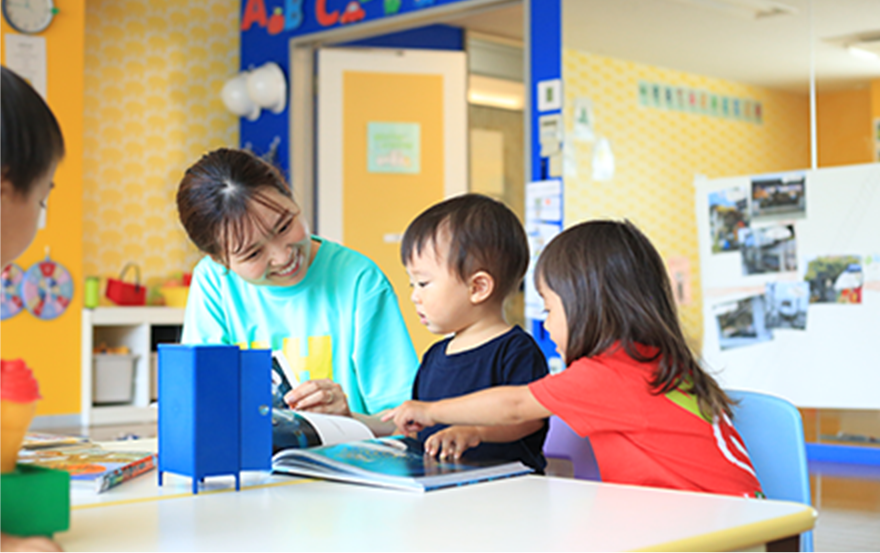
Educational Goal:Bilingual Early Education
教育目標:バイリンガル初期教育
1歳7ヶ月〜5歳児を対象としたバイリンガル教育。外国人講師と日本人保育士のもとで互いの文化を尊重しながら、この時期に育まれるバイリンガルのベースを学習し、同時に正しいしつけを身につけます。
We provide bilingual education for children from 1 year & 7 months to 5 years old.
Under the supervision and care of both English teachers and Japanese care providers, children will
build a bilingual foundation as the base of their education while learning to respect the
differences in culture that comes with this approach.
Childcare Goal:Teamwork and Manners in a Safe Environment
保育目標:安全な環境での共同作業としつけ
共同生活に慣れ親しみながら、この時期に育まれるべきしつけと言葉使いを中心に保育をしていきます。
We will introduce the concept of communal living while focusing on developing proper manners and language use between the children and their peers.
English Language Education Goal:Vocabulary and Phonics
英語教育目標:英語を話せるようになる
1歳7ヶ月〜3歳児:この時期だからこそ導入意義のあるPhonicsを中心に、生活の中で習得できるVocabularyを増やします。Vocabularyを少しづつ組み立てたシンプルな英語のセンテンスが話せるよう、日常保育の中でコミュニケーション力も育みます。3歳児〜5歳児:より多くのVocabulary、それを組み合わせたセンテンスのアウトプットを始めます。英語を聴く(Listening)、話す(Speaking)、読む(Reading)、書く(Writing)を総合的に学びます。自ら質問し、質問に答えられる力、自己表現力を育みます。
1 year & 7 months to 3 years: This age period is an optimal time in a child’s development to introduce and focus on Phonics. At the same time, we will introduce new vocabulary that the child can put together to make simple sentences in their daily life. 3 years to 5 years: We will build vocabulary to make more complex sentences by practicing the 4 language skills: Listening,Speaking,Reading and Writing.The child can ask and answer questions and develop self-expression abilitiy.
STRENGTHS[ 私たちの強み ]

Start at 1 Year and 7 Months
1歳7カ月からスタート
1歳7カ月は、日本語と英語それぞれに切り替えができる脳を育てるためのベストな時期です。言語や身体能力の発達が目覚ましいこの時期のスタートが、大きな成果に繋がります。 ※1歳7カ月未満はご相談ください
1 year and 7 months is the ideal time to begin training a child’s brain to switch between
Japanese and English. At this age, childrens’ linguistic and physical
development grow at a remarkable rate where – if we make the most of this opportunity –
we can see noticeable results.
*Please consult with us for children under 1 year and 7 months.
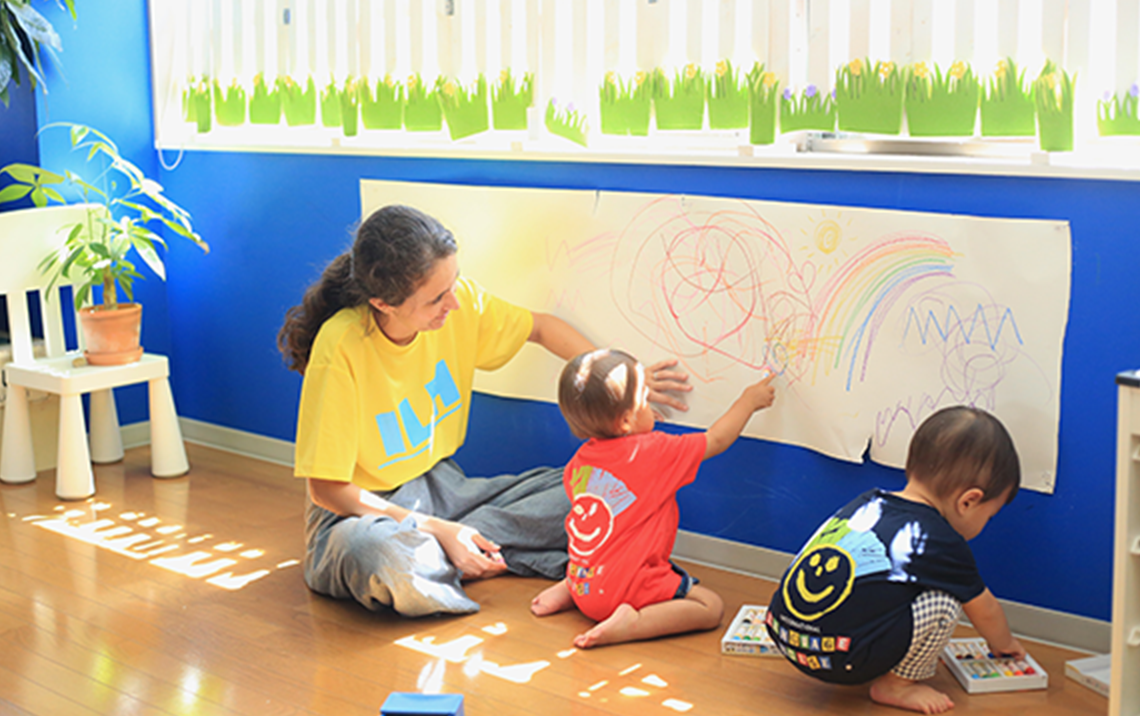
Bilingual Program
バイリンガルプログラム
外国人講師と一緒にプログラムを行うだけでなく、生活時間も共にします。そのため、子どもの在園時間すべてが英語にふれる時間。日常的に英語を耳にすることでヒアリング能力を伸ばしていきます。
Children not only participate in the structured learning program with English teachers but also go through the daily routine with them. They are consistenly exposed to English. Since they hear it on a daily basis, they are able to improve their English-listening ability – something they would not be able to do in a different environment.
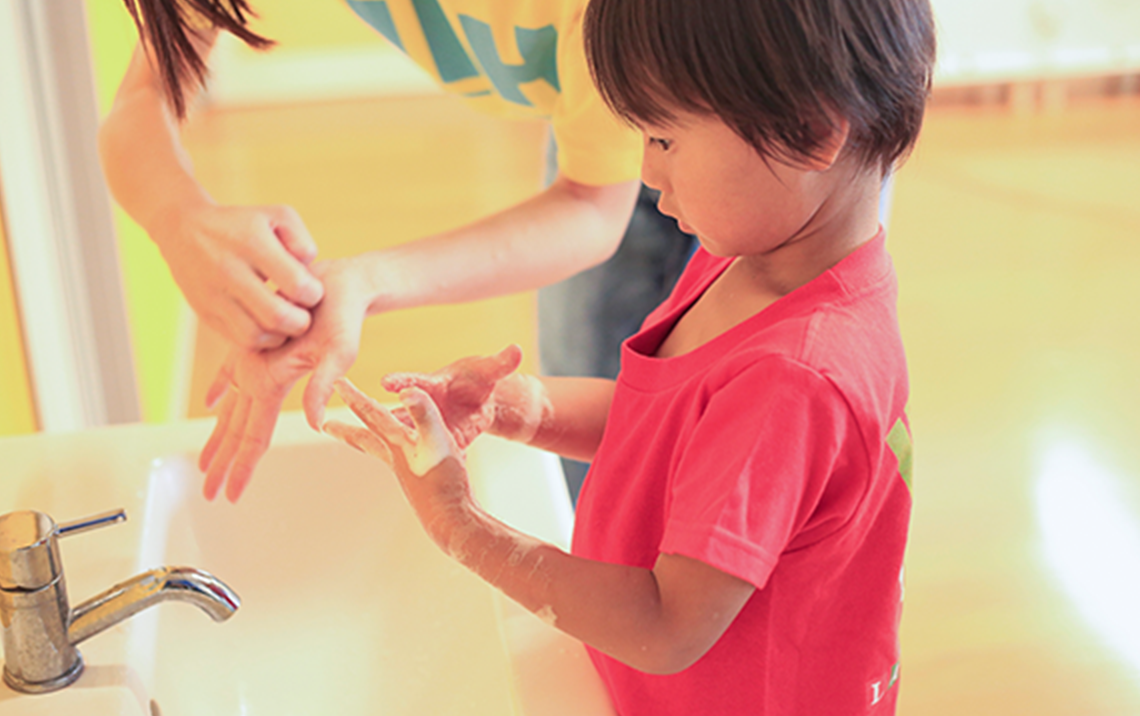
Foundational Daily Habits
生活習慣
日本人保育士が子どもたちの英語のサポートだけでなく、トイレトレーニングや着替え、片付けなどの生活習慣を身につけられるよう日本語でフォローしています。また、子育てに対するご相談にも日々応じています。
The school is staffed by qualified English teacher and experienced Japanese providers. We provide family-like childcare in small groups, carefully attending to the childrens’ development so that they can focus on enjoying their time at school.
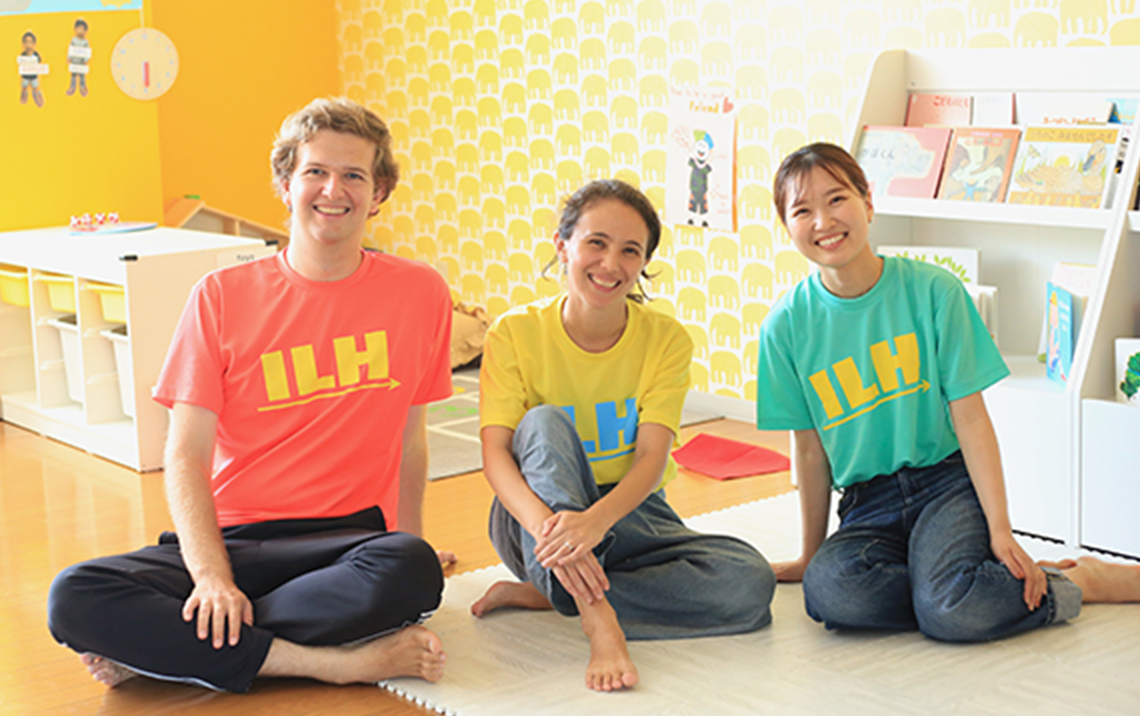
English Teachers and Japanese Providers
外国人講師と日本人保育士のW体制
外国人講師と経験豊富な日本人保育士のW体制。子どもたちの発達に注意深く寄り添い、のびのびと過ごせるように、少人数制で家庭的な保育を行っています。
The school is staffed by qualified English teachers and experienced Japanese providers. We provide family-like childcare in small groups, carefully attending to the childrens’ development so that they can focus on enjoying their time at school while building lasting relationships with their friends.
DAILY SCHEDULE[ スクールの1日 ]
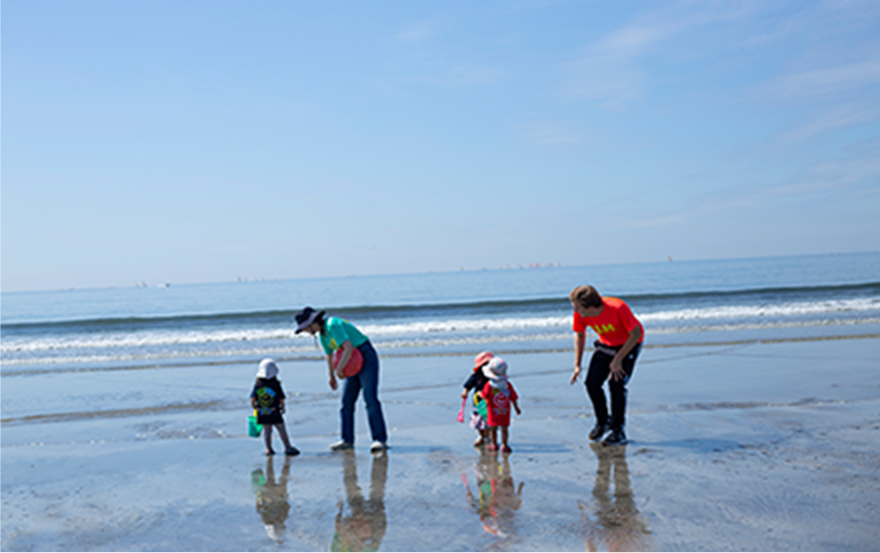
-
1. Arrival登園
-
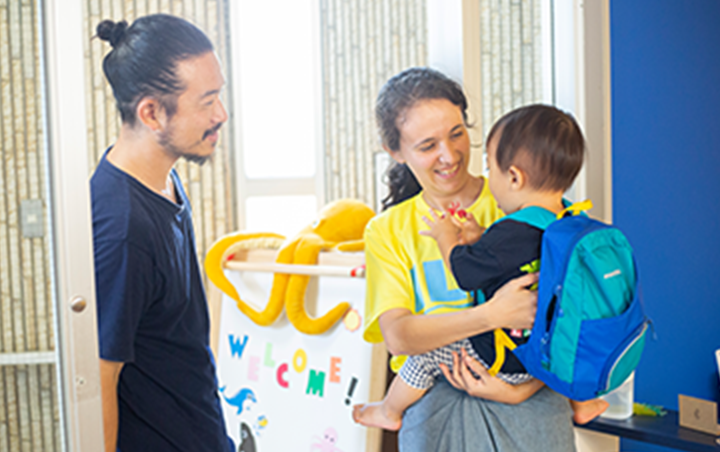 1. Arrival登園“Good morning!”ママやパパと離れても不安にならないよう、保育士たちが明るくお出迎え。保育士はどんな連絡事項もしっかりお伺いし、1日の保育にのぞみます。子どもたちは、脱いだ靴やカバンを自分でおかたづけ。“Good morning!” The Japanese provider cheerfully welcomes your child so that they won’t feel anxious about being away from their parents. The Japanese provider listens carefully to any information that needs to be communicated and then gets ready for the day’s activities. The children take off their shoes and bags and put them away.
1. Arrival登園“Good morning!”ママやパパと離れても不安にならないよう、保育士たちが明るくお出迎え。保育士はどんな連絡事項もしっかりお伺いし、1日の保育にのぞみます。子どもたちは、脱いだ靴やカバンを自分でおかたづけ。“Good morning!” The Japanese provider cheerfully welcomes your child so that they won’t feel anxious about being away from their parents. The Japanese provider listens carefully to any information that needs to be communicated and then gets ready for the day’s activities. The children take off their shoes and bags and put them away.
-
2. Daily Health Check体調確認
-
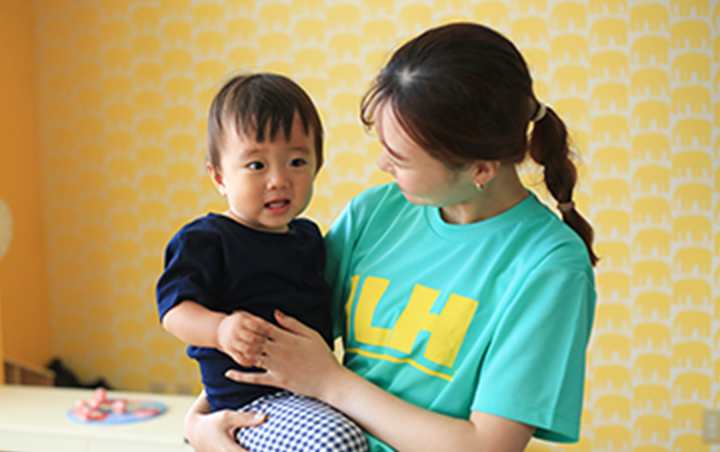 2. Daily Health Check体調確認今日も変わらず元気だね! それともちょっと泣き虫かな? お熱はないかな? おむつは大丈夫? 子どもたちが1日を元気に快適に過ごせるよう、心身の健康状態をしっかりチェックします。You’re as cheerful as ever today! Or are you a bit sad? Do you have a fever? Is your diaper okay? We carefully check the children’s physical and mental health to ensure that they can spend the day comfortably and in good health.
2. Daily Health Check体調確認今日も変わらず元気だね! それともちょっと泣き虫かな? お熱はないかな? おむつは大丈夫? 子どもたちが1日を元気に快適に過ごせるよう、心身の健康状態をしっかりチェックします。You’re as cheerful as ever today! Or are you a bit sad? Do you have a fever? Is your diaper okay? We carefully check the children’s physical and mental health to ensure that they can spend the day comfortably and in good health.
-
3. Circle Time /
Music and Dance Timeサークルタイム -
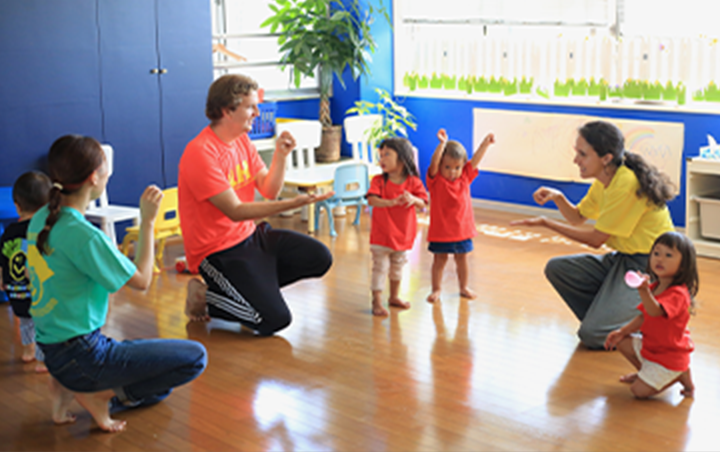 3. Circle Time /
3. Circle Time /
Music and Dance Timeサークルタイム長年、英語教育に携わってきたネイティブの先生の呼びかけで輪になったら、英語で歌って一緒にダンス。子どもたちの好奇心を刺激しながら、思いっきり体を使って英語で遊びます。The experienced English teacher calls the children over to form a circle so they can sing and dance together using English. The childrens’ curiosity is stimulated as they play in English.
-
4. English Time英語学習
-
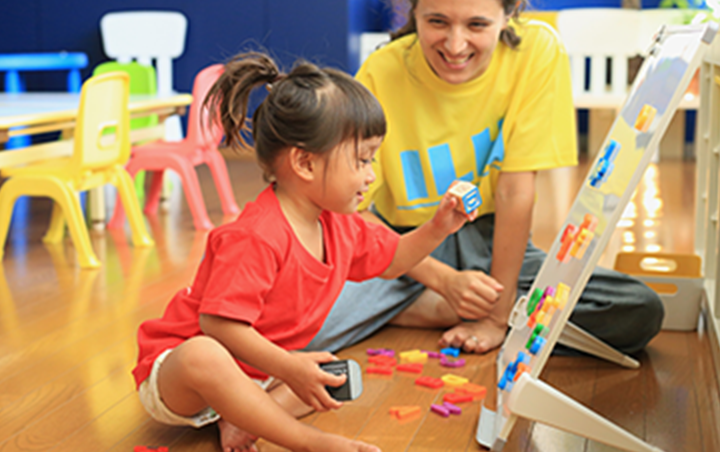 4. English Time英語学習お子さまの各年齢の発達に合わせた年間カリキュラムに沿って英語学習を行います。1歳7ヶ月は、簡単な文章で会話ができるように、フォニックスと語彙を増やすことに重点を置いています。3~5歳は、自分の考えを英語で伝えられるように、フォニックスに加え、英語を聴く(Listening)、話す(Speaking)、読む(Reading)、書く(Writing)を総合的に学びます。We follow a yearly curriculum that is tailored to the developmental needs of each age group. 1.7-3 year olds focus on Phonics and vocabulary building so that they can converse in simple sentences. 3-5 year olds learn Phonics as well as listening, speaking, reading, and writing so that they can express their thoughts in English.
4. English Time英語学習お子さまの各年齢の発達に合わせた年間カリキュラムに沿って英語学習を行います。1歳7ヶ月は、簡単な文章で会話ができるように、フォニックスと語彙を増やすことに重点を置いています。3~5歳は、自分の考えを英語で伝えられるように、フォニックスに加え、英語を聴く(Listening)、話す(Speaking)、読む(Reading)、書く(Writing)を総合的に学びます。We follow a yearly curriculum that is tailored to the developmental needs of each age group. 1.7-3 year olds focus on Phonics and vocabulary building so that they can converse in simple sentences. 3-5 year olds learn Phonics as well as listening, speaking, reading, and writing so that they can express their thoughts in English.
-
5. Activityアクティビティ
-
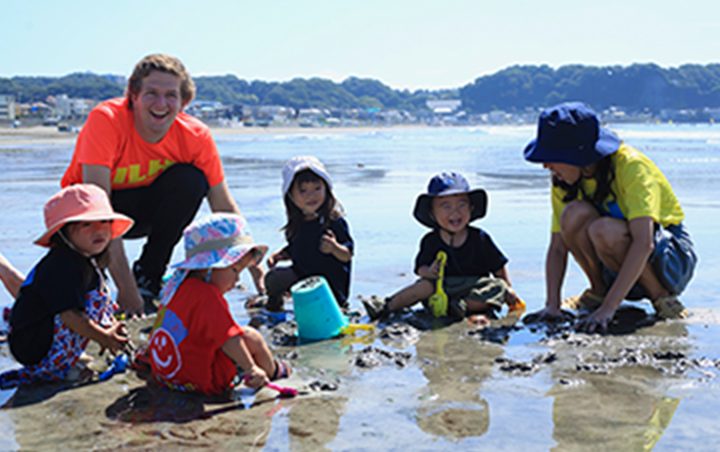 5. Activityアクティビティ先生といっしょに身支度を整えたら、お天気の良い日は海や公園、お散歩に出かけます。外国人講師と楽しく遊び、日本人保育士はしっかりと安全を見守ります。室内では、季節の製作や、行事の製作、絵の具や感触遊びなどを行います。その他にもShow&TellやCulture Sharing、Speech等バイリンガルならではのActivitiyもあります。After getting ready with their teachers, the children go to the beach, park, or out for a walk when the weather is nice. The children have fun playing with the English teachers, and the Japanese providers make sure that they are safe. In the classroom, the teachers plan seasonal and holiday arts and crafts, paint and sensory play, etc. for the children. There are also other unique bilingual activities such as Show & Tell, Culture Sharing, and Speech.
5. Activityアクティビティ先生といっしょに身支度を整えたら、お天気の良い日は海や公園、お散歩に出かけます。外国人講師と楽しく遊び、日本人保育士はしっかりと安全を見守ります。室内では、季節の製作や、行事の製作、絵の具や感触遊びなどを行います。その他にもShow&TellやCulture Sharing、Speech等バイリンガルならではのActivitiyもあります。After getting ready with their teachers, the children go to the beach, park, or out for a walk when the weather is nice. The children have fun playing with the English teachers, and the Japanese providers make sure that they are safe. In the classroom, the teachers plan seasonal and holiday arts and crafts, paint and sensory play, etc. for the children. There are also other unique bilingual activities such as Show & Tell, Culture Sharing, and Speech.
-
6. Daily Habits衛生習慣
-
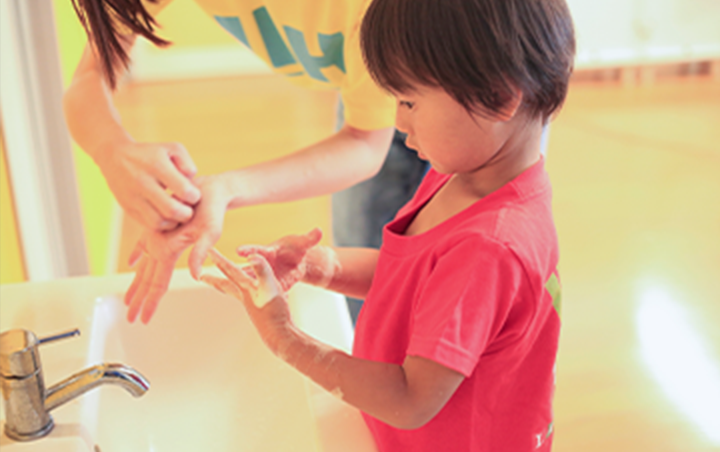 6. Daily Habits衛生習慣お散歩から戻ったら、靴を脱いで、手洗い・うがい。自分のことは自分でできるように、保育士と外国人の先生が必要に応じてお手伝いします。“Good job!”先生にも褒められたね。After returning from outside, the children take off their shoes, wash their hands, and gargle. The Japanese provider and English teacher help the children learn the basics of how to take care of themselves and provide positive reinforcement and praise, saying “Good job!”.
6. Daily Habits衛生習慣お散歩から戻ったら、靴を脱いで、手洗い・うがい。自分のことは自分でできるように、保育士と外国人の先生が必要に応じてお手伝いします。“Good job!”先生にも褒められたね。After returning from outside, the children take off their shoes, wash their hands, and gargle. The Japanese provider and English teacher help the children learn the basics of how to take care of themselves and provide positive reinforcement and praise, saying “Good job!”.
-
7. Lunch Time昼食
-
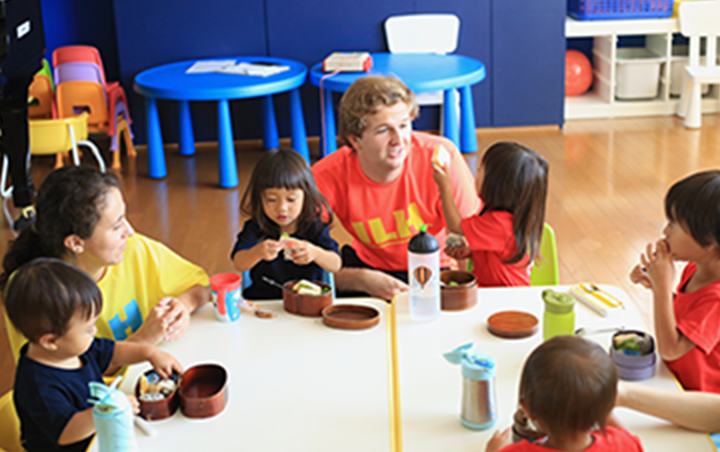 7. Lunch Time昼食「いただきます!」待ちに待ったランチタイムは、日本語のご挨拶でスタート。日本のマナーを守りながら、みんなで楽しく食べるうちに、苦手なものがある子どももパクッ!アレルギー対策も行っています。After a busy morning, the long-awaited lunch time starts with a greeting in Japanese: “Now let’s eat. Itadakimasu!” The children learn Japanese manners and also have fun eating together. Even children who don’t have a big appetite want to chow down! We also take measures against allergies.
7. Lunch Time昼食「いただきます!」待ちに待ったランチタイムは、日本語のご挨拶でスタート。日本のマナーを守りながら、みんなで楽しく食べるうちに、苦手なものがある子どももパクッ!アレルギー対策も行っています。After a busy morning, the long-awaited lunch time starts with a greeting in Japanese: “Now let’s eat. Itadakimasu!” The children learn Japanese manners and also have fun eating together. Even children who don’t have a big appetite want to chow down! We also take measures against allergies.
-
8. Story Time読書
-
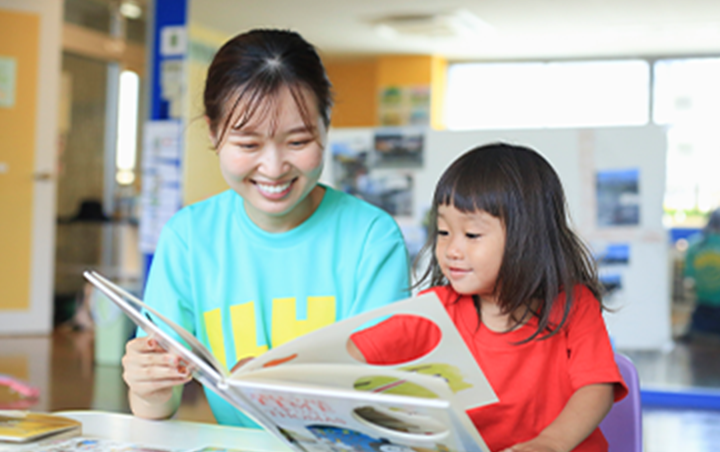 8. Story Time読書本を読むことは、語彙を増やす最も重要な方法のひとつです。同じ本を繰り返し読むことで、英文法の理解だけでなく、流暢さも養うことができます。年齢が上がるにつれて、子どもたちは自主的に本を読むようになります。最大の目標は、幼少期から読書を好きになってもらうことです。Reading books is one of the most important ways to build vocabulary. By reading the same books repeatedly, children can develop their fluency as well as their understanding of English grammar. As the children grow older, they will start to read books independently. Our biggest goal is to develop a love of reading from a young age.
8. Story Time読書本を読むことは、語彙を増やす最も重要な方法のひとつです。同じ本を繰り返し読むことで、英文法の理解だけでなく、流暢さも養うことができます。年齢が上がるにつれて、子どもたちは自主的に本を読むようになります。最大の目標は、幼少期から読書を好きになってもらうことです。Reading books is one of the most important ways to build vocabulary. By reading the same books repeatedly, children can develop their fluency as well as their understanding of English grammar. As the children grow older, they will start to read books independently. Our biggest goal is to develop a love of reading from a young age.
-
9. Nap Timeお昼寝
-
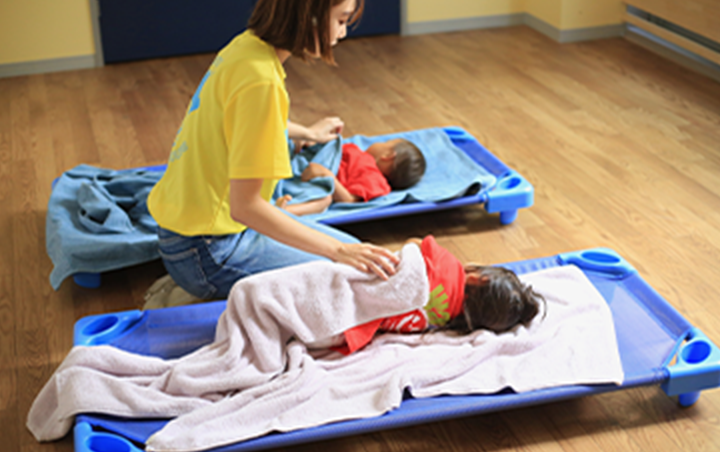 9. Nap Timeお昼寝午前中、頭も体もたくさん動かした子どもたちは夢の中へ。眠れない子には、先生がやさしく付き添います。寝ている間もしっかり見守り、うつぶせ寝防止に努めています。ゆっくり休んだら、またいっぱい遊ぼうね。Since the children have spent all morning exercising their minds and bodies, they quickly fall asleep. For those who cannot sleep, the teachers stay nearby to provide emotional support. The Japanese providers keep a close eye on the children while they sleep to prevent them from falling asleep on their stomach. After a good rest, the children are ready to play together again.
9. Nap Timeお昼寝午前中、頭も体もたくさん動かした子どもたちは夢の中へ。眠れない子には、先生がやさしく付き添います。寝ている間もしっかり見守り、うつぶせ寝防止に努めています。ゆっくり休んだら、またいっぱい遊ぼうね。Since the children have spent all morning exercising their minds and bodies, they quickly fall asleep. For those who cannot sleep, the teachers stay nearby to provide emotional support. The Japanese providers keep a close eye on the children while they sleep to prevent them from falling asleep on their stomach. After a good rest, the children are ready to play together again.
-
10. Snack Timeおやつ
-
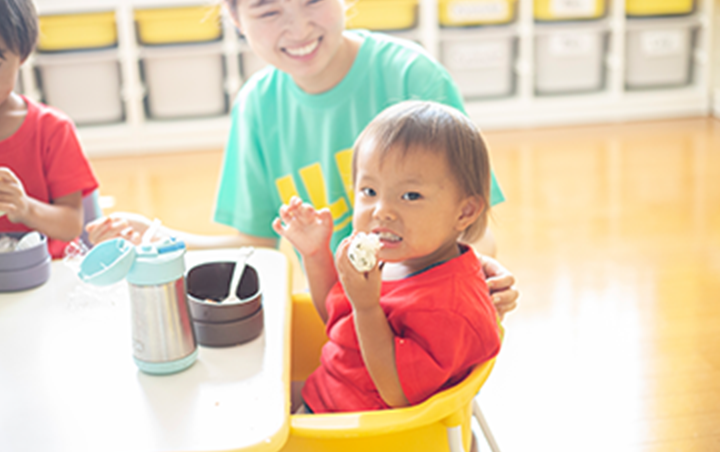 10. Snack Timeおやつお昼寝から目覚めたら、みんなが大好きなおやつの時間です。“Cookie!”、“Bread!”今日は、みんなどんなおやつを持ってきているのかな?After waking up from naptime, it’s time for everyone’s favorite snack. “Cookie!”, “Bread!” What kind of snacks are you bringing today?
10. Snack Timeおやつお昼寝から目覚めたら、みんなが大好きなおやつの時間です。“Cookie!”、“Bread!”今日は、みんなどんなおやつを持ってきているのかな?After waking up from naptime, it’s time for everyone’s favorite snack. “Cookie!”, “Bread!” What kind of snacks are you bringing today?
-
11. Pick-up Time降園
-
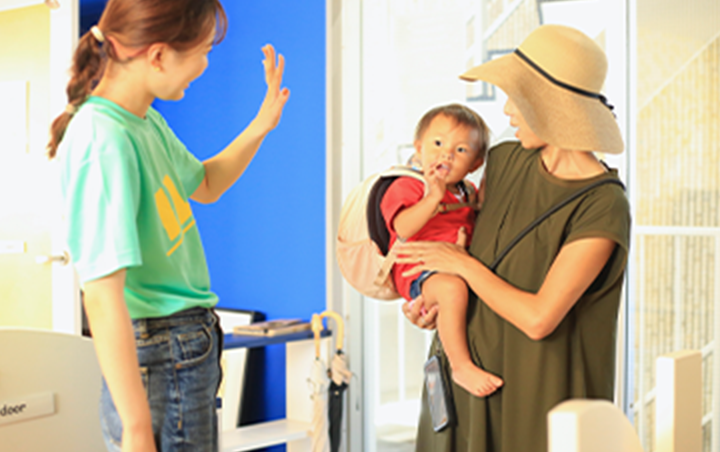 11. Pick-up Time降園15時のお子さまは帰宅します。“See you!”英語で帰りの歌を歌ったら1日の終わり。お迎えに来たママ・パパには、保育士が今日の子どもたちの様子を報告します。ときにアート作品をママやパパに手渡す子どもたちはちょっと誇らしげ。At 3:00 p.m., it’s pick-up time. “See you!” We sing the goodbye song in English to end the day. When parents come to pick up their children, the Japanese provider gives them a full report on how the children did that day. The children love showing their parents the artwork or craft they made with the teachers.
11. Pick-up Time降園15時のお子さまは帰宅します。“See you!”英語で帰りの歌を歌ったら1日の終わり。お迎えに来たママ・パパには、保育士が今日の子どもたちの様子を報告します。ときにアート作品をママやパパに手渡す子どもたちはちょっと誇らしげ。At 3:00 p.m., it’s pick-up time. “See you!” We sing the goodbye song in English to end the day. When parents come to pick up their children, the Japanese provider gives them a full report on how the children did that day. The children love showing their parents the artwork or craft they made with the teachers.
-
12. Free Play自由あそび
-
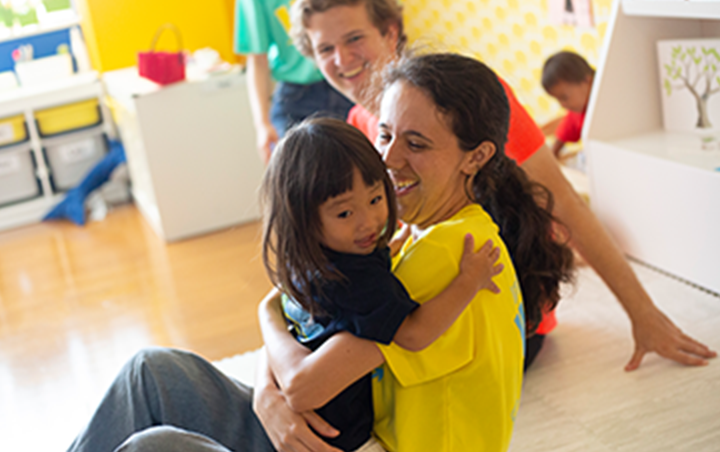 12. Free Play自由あそび“Let’s play together!”先生と一緒に英語でゲームをしたり、お友だちとカラフルな外国のブロックで遊んだり…。遊びのなかに英語を取り入れる工夫を凝らし、国際的なコミュニケーション能力を育んでいきます。その後はお迎え時間に合わせ、順次降園します。“Let’s play together!”The children play games in English with teachers and friends. Together, they play with colorful alphabet blocks. We devise ways to incorporate English into play and foster international communication skills. Afterwards, children will be dismissed according to their pick-up time.
12. Free Play自由あそび“Let’s play together!”先生と一緒に英語でゲームをしたり、お友だちとカラフルな外国のブロックで遊んだり…。遊びのなかに英語を取り入れる工夫を凝らし、国際的なコミュニケーション能力を育んでいきます。その後はお迎え時間に合わせ、順次降園します。“Let’s play together!”The children play games in English with teachers and friends. Together, they play with colorful alphabet blocks. We devise ways to incorporate English into play and foster international communication skills. Afterwards, children will be dismissed according to their pick-up time.
Q&A[ よくある質問 ]
-
母子分離での保育は初めてで不安です。最初から母子分離なのでしょうか?This will be the first time being away from my child. Will we be separated from the beginning?
-
ランゲージ・ハウスKamakuraの保育は、母子分離が基本です。お子さまひとりで先生やお友だちとコミュニケーションをとるうちに、自立心が芽生えていきます。One of our nursery school’s basic principles is to separate parents and their child from the beginning. As your child communicates with teachers and friends on his or her own, he or she will develop a sense of independence.
-
保育は、すべて英語で行われるのでしょうか。日本語を忘れてしまわないか心配です。Will all childcare be conducted in English? I am worried that my child will forget Japanese.
-
ランゲージ・ハウスKamakuraでの保育は、日本語と英語の両方で行われます。外国人の先生・日本人の保育士とお話をするうちに、2つの言語が自然と身に付きます。Childcare at the school is provided in both Japanese and English. The two languages are naturally acquired as the children talk with the English teachers and Japanese providers.
-
給食はありますか?Is school lunch provided?
-
幼児期は「食べられた!」という食体験の積み重ねが大切です。そのため一律の給食ではなく、お子さまに合わせたお弁当の準備をお願いします。In early childhood, during meals it is important to build on the experience of “I can eat it!”. For this reason, we ask that you prepare a lunch box that is tailored to your child’s needs, rather than a uniform school lunch.
-
お弁当は、どのようなメニューが良いのでしょうか。What type of menu is best for the lunch box?
-
お子さまが好きなメニューを中心に一口大にしていただくと食が進むようです。量や食材については、保育士と相談しながらご調整をお願いします。Bite-size portions consisting of mainly of your child’s favorite foods are likely to be more appetizing. Please consult with the provider regarding the amount and ingredients.
-
フリープレイでは、どんなことをしますか。What do you do in free play?
-
フリープレイでは、外国人講師と一緒にダンスや歌を楽しみながら英語に親しみます。日本人保育士とは日本の手遊びやうたで遊びます。During free play time, children enjoy dancing and singing with English teachers, while becoming familiar with English. With Japanese providers, children engage in Japanese fingerplay and songs.
-
教室での様子は、教えていただけますか?How can parents receive updates about classroom activities?
-
お子さまのご様子は、コミュなびアプリからご確認頂けます。それに限らず、ご心配なことはいつでもご相談ください。You will be provided with updates about your child through the Communavi App. Please feel free to contact us anytime with any concerns you may have.
-
保育時間の変更はできますか?Can I change the childcare hours?
-
お迎え時間は、子どもたちの活動にあわせて、13時、15時、18時でお願いしています。急なご予定による延長もお気軽にご相談ください。Pick-up times are requested at 1:00 p.m., 3:00 p.m. and 6:00 p.m. to accommodate children’s activities. Please feel free to contact us for extensions due to sudden schedule changes.
-
保育は週5日利用しなければなりませんか?Do I have to use childcare 5 days per week?
-
保育は週2回からお引き受けしています。週2~週5までお選びください。We provide childcare starting from a minimum of 2 days per week. Please choose from 2 to 5 days per week.
-
登園時間は何時でしょうか?遅れてしまいそうなときは?What time is drop off? What if I am going to be late?
-
朝のプログラムをみんなで楽しむために、登園は8時から9時の間でお願いしています。遅れる場合はご連絡をお願いします。In order for everyone to enjoy the morning program, we ask that you arrive at the school between 8:00 and 9:00 am. Please contact us if you will be late.
-
夏休みや冬休みなど、長期休園はありますか?Are there any long vacations, such as summer or winter vacation?
-
お盆やクリスマス期間中は、お休みとなります。日程についてはスケジュールをご確認ください。We will be closed during the Obon and Christmas periods. Please check the schedule for dates.
-
保育時間中に、トイレトレーニングはしてもらえますか?Can my child be potty-trained during childcare hours?
-
トイレトレーニングは、お子さまの様子を見ながら相談して進めていきます。パンツに切替えるタイミングについても保育士にご相談ください。Toilet training will be discussed with you while monitoring your child’s progress. Please consult with Japanese providers about when to switch to underwear.
-
お外での活動も行いますか?Do you offer outside activities?
-
お天気の良い日は、海や公園、お散歩にでかけます。お外でしかできない経験のなかで生きた英語を身に着けます。Depending on the weather we go to the beach, park, or for a walk. The children absorb Enlish through these experiences outside.
-
バスでの登園はできますか?Can I take the bus to the school?
-
送迎バスは現在ありません。There is currently no shuttle bus service.
BLOG[ ブログ ]
MOREWHY BILINGUAL ?[ なぜバイリンガルなのか? ]
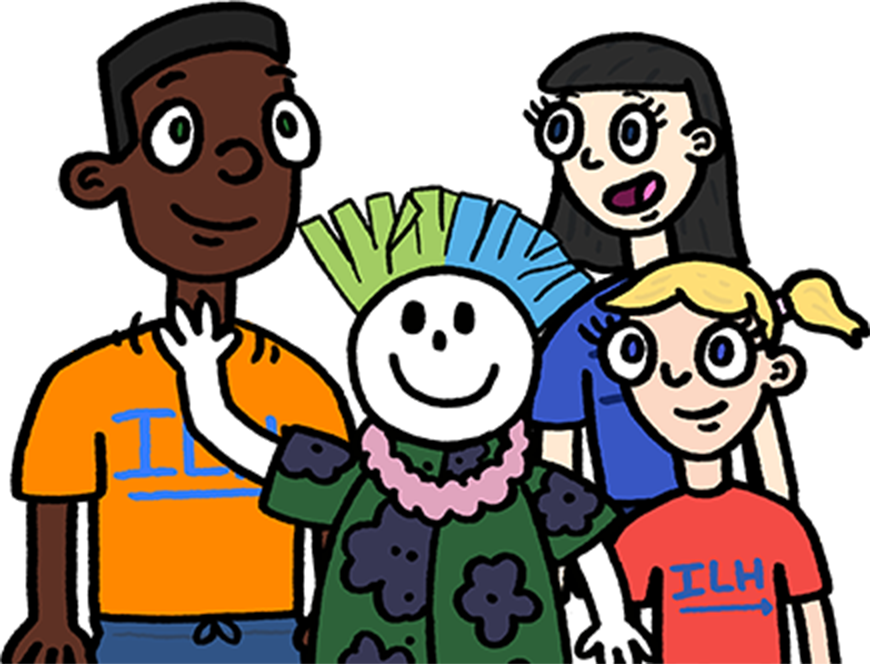
About
Language House Kamakura
- 施設名
- ランゲージ・ハウス Kamakura
- 開園
- 2023年7月1日
- 代表
- 黒部 美子
- 電話
- 0467-73-7550
- 住所
-
〒248-0012神奈川県鎌倉市御成町4-17
鎌倉御成町ビル2F
- 責任者
- 黒部 美子
- Name
- Language House Kamakura
- Established
- July 1, 2023
- CEO
- Yoshiko Kurobe
- TEL
- 0467-73-7550
- Address
- 4-17 2F Kamakura Onarimachi Building Onarimachi, Kamakura, Kanagawa 248–0012
- Director
- Yoshiko Kurobe


